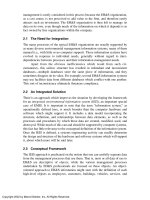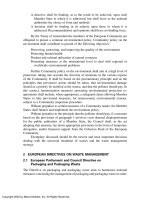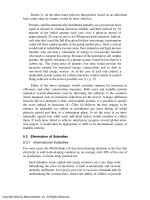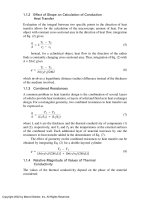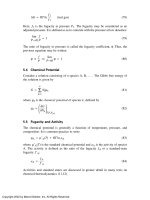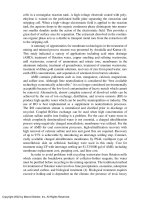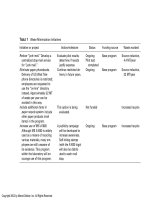AS 1670 3 1997 fire detection, warning control and intercom
Bạn đang xem bản rút gọn của tài liệu. Xem và tải ngay bản đầy đủ của tài liệu tại đây (156.97 KB, 13 trang )
Title
AS 1670.3-1997 Fire detection, warning control and intercom systems - System,
design, installation and commissioning - Monitoring network performance
Licensee
Licensed to LUU MINH LUAN on 25 Feb 2002
Conditions of use
This is a licensed electronic copy of a document where copyright is owned or managed by
Standards Australia International. Your licence is a single user licence and the document may not
be stored, transferred or otherwise distributed on a network. You may also make one paper copy
of this document if required.
Web Check-up
AS 1670.3—1997
Licensed to LUU MINH LUAN on 25 Feb 2002. Single user licence only. Storage, distribution or use on network prohibited.
Australian Standard
Fire detection, warning, control and
intercom systems—System design,
installation and commissioning
Part 3: Monitoring network
performance
This Australian Standard was prepared by Committee FP/2, Fire Detection,
Warning, Control and Intercom Systems. It was approved on behalf of the Council
of Standards Australia on 6 December 1996 and published on 5 February 1997.
The following interests are represented on Committee FP/2:
Audio Engineering Society
Australian Building Codes Board
Australian Chamber of Commerce and Industry
Australian Chamber of Manufactures
Australian Electrical and Electronic Manufacturers Association
Australian Fire Authorities Council
Australian Fire Protection Association
Commonwealth Fire Board
Licensed to LUU MINH LUAN on 25 Feb 2002. Single user licence only. Storage, distribution or use on network prohibited.
CSIRO — Division of Building, Construction and Engineering
Deafness Forum of Australia
Department of Defence
Fire Protection Industry Association of Australia
Fire Protection Industry Contractors Association of New Zealand
Insurance Council of Australia
National Electrical Contractors Association of Australia
New Zealand Fire Equipment Association
New Zealand Fire Protection Association
New Zealand Fire Protection Industry Contractors Association
Property Council of Australia
Scientific Services Laboratory AGAL — Department of Administrative Services
Telstra Corporation
Review of Australian Standards. To keep abreast of progress in industry, Australi an Standards are
subject to periodic review and are kept up to date by the issue of amendments or new editions as
necessary. It is important therefore that Standards users ensure that they are in possession of the latest
editi on, and any amendments thereto.
Full details of all Australi an Standards and related publicati ons will be found in the Standards Australia
Catalogue of Publications; this information is supplemented each month by the magazine ‘The
Australian Standard’, which subscribing members receive, and which gives details of new publications,
new editions and amendments, and of withdrawn Standards.
Suggestions for improvements to Australian Standards, addressed to the head office of Standards
Australia, are welcomed. Notification of any inaccuracy or ambiguity found in an Australian Standard
should be made wit hout delay in order that the matter may be investigated and appropriate action taken.
This Standard was issued in draft form for comment as DR 96018.
AS 1670.3—1997
Licensed to LUU MINH LUAN on 25 Feb 2002. Single user licence only. Storage, distribution or use on network prohibited.
Australian Standard
Fire detection, warning, control and
intercom systems—System design,
installation and commissioning
Part 3: Monitoring network
performance
PUBLISHED BY STANDARDS AUSTRALIA
(STANDARDS ASSOCIATION OF AUSTRALIA)
1 THE CRESCENT, HOMEBUSH, NSW 2140
ISBN 0 7337 0911 7
AS 1670.3 — 1997
2
PREFACE
This Standard was prepared by the Joint Standards Australia/Standards New Zealand
Committee FP/2, Fire Detection, Warning, Control and Intercom Systems.
This Standard is a result of a consensus among representatives on the Joint Committee to
produce it as an Australian Standard.
This Standard sets down minimum performance requirements for a network used to
monitor automatic fire detection and alarm systems using the communications protocol
defined in AS 4418.2, Supervisory control and data acquisition (SCADA)—Generic
telecommunications interface and protocol, Part 2: Fire alarm systems. This Standard has
been published for the use of equipment manufacturers and monitoring service providers
in the fire industry; however, other industry groups may find the performance
requirements applicable.
Licensed to LUU MINH LUAN on 25 Feb 2002. Single user licence only. Storage, distribution or use on network prohibited.
AS 4418.2 has been prepared to be consistent with requirements developed by IEC and
published in the IEC 870 series of International Standards, Telecontrol equipment and
systems.
The term ‘informative’ has been used in this Standard to define the application of the
appendix to which it applies. An ‘informative’ appendix is only for information and
guidance.
Copyright
STANDARDS AUSTRALIA
Users of Standards are reminded that copyright subsists in all Standards Australi a publications and software. Except where the
Copyri ght Act allows and except where provided for below no publi cati ons or software produced by Standards Austr alia may be
reproduced, stored in a retri eval system in any form or transmitt ed by any means wit hout prior permission in wri ti ng from
Standards Austr alia. Permission may be conditi onal on an appropri ate royalty payment. Requests for permission and information
on commercial soft ware royalt ies should be dir ected to the head off ice of Standards Australi a.
Standards Austr alia wil l permit up to 10 percent of the technical content pages of a Standard to be copied for use
exclusively in-house by purchasers of the Standard without payment of a royalty or advice to Standards Austr alia.
Standards Austr alia will also permit the inclusion of its copyri ght material in computer soft ware programs for no royalt y
payment provided such programs are used exclusively in-house by the creators of the programs.
Care should be taken to ensure that material used is fr om the current editi on of the Standard and that it is updated whenever the
Standard is amended or revised. The number and date of the Standard should therefore be clearly identif ied.
The use of materi al in pri nt form or in computer soft ware programs to be used commerciall y, wit h or wit hout payment, or in
commercial contr acts is subject to the payment of a royalt y. This policy may be varied by Standards Australi a at any ti me.
3
AS 1670.3 — 1997
CONTENTS
Page
Licensed to LUU MINH LUAN on 25 Feb 2002. Single user licence only. Storage, distribution or use on network prohibited.
SECTION 1 SCOPE AND GENERAL
1.1 SCOPE . . . . . . . . . . . . . . . . . . . . . . . . . . . . . . . .
1.2 APPLICATION . . . . . . . . . . . . . . . . . . . . . . . . . .
1.3 REFERENCED AND RELATED DOCUMENTS . . .
1.4 DEFINITIONS . . . . . . . . . . . . . . . . . . . . . . . . . . .
.. ..
. ...
.. ..
.. ..
..
..
..
..
... ........
.. .. .. ... ..
.. ... ......
. ... .. .....
4
4
4
5
SECTION 2 PERFORMANCE REQUIREMENTS
2.1 GENERAL . . . . . . . . . . . . . . . . . . . . . . . . . . . . . . . . . . . . . . . . . . . . . .
2.2 NON-PERMANENTLY CONNECTED CONTROLLED STATIONS . . . . . .
2.3 PERMANENTLY CONNECTED CONTROLLED STATIONS . . . . . . . . . .
2.4 MULTIPLE STATUS CHANGES . . . . . . . . . . . . . . . . . . . . . . . . . . . . . . .
6
6
6
7
APPENDIX A
8
SYSTEM OVERVIEW . . . . . . . . . . . . . . . . . . . . . . . . . . . . . . . .
First published as AS 1670.3— 1997.
AS 1670.3 — 1997
4
STANDARDS AUSTRALIA
Australian Standard
Fire detection, warning, control and intercom systems—
System design, installation and commissioning
Part 3: Monitoring network performance
S E C T I O N
1
S CO P E
A N D
G E NE R A L
1.1 SCOPE This Standard sets out performance requirements for fire alarm monitoring
networks using the telecommunications protocol defined in AS 4418.2.
1.2 APPLICATION The performance requirements of this Standard are applicable to
supervisory control and data acquistion (SCADA) networks for fire alarm monitoring
applications.
Licensed to LUU MINH LUAN on 25 Feb 2002. Single user licence only. Storage, distribution or use on network prohibited.
NOTE: See Appendix A for system overview.
The performance requirements for both permanently connected controlled stations and
non-permanently connected controlled stations are specified.
NOTE: Non-permanently connected controlled stations are not considered adequate for
installations required to be monitored under the Building Code of Australia.
1.3
REFERENCED AND RELATED DOCUMENTS
1.3.1
Referenced documents
AS
2484
2484.2
The following documents are referred to in this Standard:
Fire— Glossary of terms
Part 2: Fire protection and firefighting equipment
AS/NZS
4418
Supervisory control and data acquisition —Generic telecommunications interface
and protocol
4418.2
Part 2: Fire alarm systems
IEC
870
870-4
870-5-5
1.3.2
Related documents Attention is drawn to the following related documents:
IEC
870
870-1-1
870-1-2
870-1-3
870-1-4
IEC
870-2-1
870-3
Telecontrol equipment and systems
Part 4: Performance requirements
Part 5: Transmission protocols— Section 5: Basic application functions
Telecontrol equipment and systems
Part 1: General considerations — Section 1: General principles
Part 1: General considerations — Section 2: Guide for specifications
Part 1: General considerations — Section 3: Glossary
Part 1: General considerations— Section 4: Basic aspects of telecontrol data
transmission and organization of standards IEC 870-5 and IEC 870-6
Part 2: Operating conditions — Section 1: Environmental conditions and power
supplies
Part 3: Interfaces (electrical characteristics)
COPYRIGHT
5
IEC
870-5-1
870-5-2
870-5-3
870-5-4
AS 1670.3 — 1997
Part 5: Transmission protocols— Section 1: Transmission frame formats
Part 5: Transmission protocols— Section 2: Link transmission procedures
Part 5: Transmission protocols— Section 3: General structure of application
data
Part 5: Transmission protocols — Section 4: Definition and coding of
application information elements
1.4 DEFINITIONS For the purpose of this Standard, the definitions in the IEC 870
series of Standards, AS 2484.2 and those below apply.
1.4.1 Alarm signalling equipment (ASE)— equipment designed to communicate alarm
and fault signals and other information between a fire alarm system and a monitoring
service.
1.4.2 Monitoring service — a controlling station which receives fire alarm signals and
transfers the signals to a fire brigade via a direct data link.
Licensed to LUU MINH LUAN on 25 Feb 2002. Single user licence only. Storage, distribution or use on network prohibited.
1.4.3 Non-permanently connected controlled station — a controlled station which is
not permanently connected to a controlling station, such as a station which utilizes the
public switched telephone network to make the communications link.
1.4.4 Permanently connected controlled station —a controlled station which is
permanently connected, or appears permanently connected, to a controlling station.
COPYRIGHT
AS 1670.3 — 1997
S E C T I O N
6
2
P ER F OR MA N C E
R E Q U I R E M E N T S
2.1 GENERAL The SCADA network shall conform to the requirements of the
following performance classes, set out in IEC 870-4:
(a)
Reliability class R2 (MTBF ≥4000 h).
(b)
Maintainability class M3 (MTTR ≤12 h).
(c)
Repair time class RT3 (MRT ≤6 h).
(d)
Data integrity class I2 (IE ≤10 −10).
The SCADA network configuration shall allow both non-permanently
controlled stations and permanently connected controlled stations.
connected
2.2 NON-PERMANENTLY CONNECTED CONTROLLED STATIONS Nonpermanently connected controlled stations shall be configured to connect as point-to-point.
The SCADA network shall be configured to ensure the following:
Licensed to LUU MINH LUAN on 25 Feb 2002. Single user licence only. Storage, distribution or use on network prohibited.
(a)
Status changes processed by the control and indicating equipment (CIE) are received
by the controlling station within 10 s of the establishment of the connection between
the controlled station and the controlling station.
NOTE: ASE should be configured to commence immediate calling of the controlling station
upon confirmation of an alarm system status change.
(b)
The alarm system status summary of the controlled station is reported to the
controlling station at least once every 24 h.
(c)
A test of the controlled station is undertaken by the controlling station at least once
every 24 h.
2.3 PERMANENTLY CONNECTED CONTROLLED STATIONS Permanently
connected controlled stations shall be configured as point-to-point or multiple point-topoint.
Permanently connected controlled stations shall include an alternative facility which is
used in the event of the loss of the permanent link. If the time-out interval for repeated
frame transmissions is exceeded on the permanent link, the controlled station shall attempt
to contact the controlling station via the alternative facility. In the event of the loss of the
permanent link an indication shall be given at both the controlled station and the
controlling station. If the permanent link is unavailable, the performance requirements of
Clause 2.2 shall be met.
The SCADA network shall be configured to ensure the following:
(a)
Actuating device alarm status changes processed by CIE are received by the
controlling station within 15 s.
(b)
A telecommunications link failure from the controlled station is detected by the
controlling station within 90 s.
(c)
Device fault, device isolate, alarm system isolate, CIE status and field terminal
request status changes at the controlled station are received by the controlling
station within 30 s of notification of the status change by the controlled station.
(d)
CIE device configuration changes are received by the controlling station within
10 min of notification.
(e)
A test of the controlled station is undertaken by the controlling station at least once
every 24 h.
(f)
Availability class A3 (A ≥99.95%) of IEC 870-4.
COPYRIGHT
7
AS 1670.3 — 1997
2.4 MULTIPLE STATUS CHANGES If multiple status changes occur at the CIE
simultaneously, the priority order for the controlled station to notify the controlling
station shall be as follows:
Actuating device alarm.
(b)
CIE status.
(c)
Actuating device fault.
(d)
Actuating device isolate.
(e)
CIE device configuration change.
(f)
Building data change.
(g)
Alarm system maintenance contractor change.
(h)
Field terminal session.
Licensed to LUU MINH LUAN on 25 Feb 2002. Single user licence only. Storage, distribution or use on network prohibited.
(a)
COPYRIGHT
AS 1670.3 — 1997
8
APPENDIX A
SYSTEM OVERVIEW
(Informative)
A1 GENERAL The protocol allows for both permanently connected fire alarm systems
and fire alarm systems which connect to the controlling station via the public switched
telephone network.
Balanced transmission is used to ensure adequate reporting response of alarm conditions.
Polling is not used (in conformance to IEC 870-5-5 for balanced transmission); however,
cyclic transmission from each controlled station may be used to confirm the integrity of
the communications link. Event initiated transmission is used to report alarm system
status changes. Messages are either SEND/CONFIRM (e.g. for alarm system status, clock
synchronization) or REQUEST/RESPOND (e.g. for details of actuating device in alarm).
Licensed to LUU MINH LUAN on 25 Feb 2002. Single user licence only. Storage, distribution or use on network prohibited.
Cyclic transmission is used by non-permanently connected controlled stations to report the
alarm system status summary at least once every 24 h. Permanently connected controlled
stations may report an alarm system status summary or may use other techniques to
ensure the integrity of the transmission path.
Whilst this Standard specifies many features and a high degree of functionality, other
systems can still be accommodated. Most responses from a controlled station allow a
particular message from a particular controlling station to be ‘not implemented’. This can
be used by manufacturers to enable the production of a partially functional yet fully
compliant alarm system DTE. For example, the text area available for the description of
the location of the actuating devices may be used to describe the area of an alarm zone,
thus permitting the connection of collective CIE. In this case, references to actuating
devices should be read as alarm zones.
A2 INITIALIZATION Initialization may occur as a result of a local power switch on,
a local manual reset or the controlling station remotely resetting the controlled station.
When powered up and enabled, the alarm signalling equipment (ASE) will begin to
attempt to establish the link to the controlling station. When the link is established the
controlling station begins an initialization procedure. The following steps are undertaken:
(a)
The delay acquisition time is calculated to ensure the clocks are synchronized.
(b)
The controlling station time is sent to the controlled station.
(c)
Data resident in the controlled station is obtained by the controlling station. This
includes—
(i)
the manufacturer and product specification of the alarm system;
(ii)
the alarm system summary, which includes CIE fault status, alarm system
maintenance contractor, building classification and number of occupants; and
(iii)
all actuating devices, their current status and location within the protected
premises.
Once initialization has occurred, the data resident in the controlled station and controlling
station should be identical. If the link fails, however, a buffer is used to queue events for
reporting upon re-establishment of the link.
If initialization occurs to a previously connected controlled station, the controlled station
indicates to the controlling station whether or not the initialization is occurring with or
without changes to local parameters. This enables a more efficient initialization procedure
to be undertaken by the controlling station.
COPYRIGHT
9
AS 1670.3 — 1997
A3 CLOCK The controlling station is the master clock. Clock synchronization occurs
if time tags on messages received from controlled stations exceed 10 s variation from the
controlling station time. Prior to clocks being synchronized, the delay acquisition time is
re-determined to allow for variations in the transmission link performance.
If more than ten clock synchronizations are required in any 24 h period, or the time
variation exceeds 60 s, the controlling station operator is notified.
A4 STATUS CHANGES Status changes are reported spontaneously by the controlled
station as event-initiated reports. Both alarm system summary changes and fire alarms
detected by actuating devices are reported in the following ways:
(a)
If the alarm system summary message reports a non-fire alarm controlled station
status change, the controlling station interrogates the controlled station, if necessary,
for details of the change. Some changes, such as a change in the maintenance
contractor, do not require further interrogation.
All alarm system status changes are required to be obtained by the controlled station
within the performance parameters of this Standard.
Licensed to LUU MINH LUAN on 25 Feb 2002. Single user licence only. Storage, distribution or use on network prohibited.
(b)
If the alarm state of an actuating device changes, the status of the actuating device
is reported spontaneously by the controlled station to the controlling station.
A5 TESTING Remote testing of the controlled station is undertaken by the controlling
station at least once every 24 h. Testing may also be initiated at the controlled station.
Test initiation is followed by the controlled station reporting alarm, fault, isolate and
normal conditions sequentially to the controlling station. All conditions are acknowledged
by the controlling station.
A6 FIELD TERMINAL Provision has been made to allow a dialogue between the
controlled station and the controlling station via a terminal connected to the link. This
may be at the CIE or elsewhere (such as the manufacturer’s premises). Dialogue
procedures are defined in AS 4418.2; however, the level and extent of data access is to be
determined between the monitoring service provider and the maintenance contractor.
Terminal sessions may use the file transfer type idents, as defined in AS 4418.2, to obtain
copies of data held by the controlling station, including event history logs, for the purpose
of post-event investigation and analysis.
A7 LINK FAILURE A communications link failure results in permanently connected
controlled stations attempting to use the alternative facility. A failure to establish
communications on both the permanent and alternative link is detected by the controlling
station by the non-receipt of expected cyclic transmission messages and may result in the
controlling station attempting to establish communications with the controlled station.
A failure of either communications link is reported at the controlling station and at the
controlled station.
A8 EMERGENCY OPERATION A number of remote functions may be used upon
request to assist with the operation of the controlled station in an emergency situation.
These include—
(a)
enabling and disabling the local emergency warning system;
(b)
enabling and disabling the local warning bell;
(c)
resetting actuating devices; and
(d)
isolating, and de-isolating, actuating devices in a particular device address range.
These functions allow for basic operations to be executed without the need for responding
firefighters to access the fire indicator panel.
COPYRIGHT
AS 1670.3 — 1997
10
A9 LOCAL OPERATION OF THE CONTROLLED STATION If desired, during
maintenance for example, the controlled station can be effectively isolated from the
controlling station. Communication continues, but events do not result in actions by
controlling station operators.
Licensed to LUU MINH LUAN on 25 Feb 2002. Single user licence only. Storage, distribution or use on network prohibited.
Alarm system isolation is protected by a means such as the use of passwords, whether the
isolation is initiated at the controlling station or the controlled station.
COPYRIGHT


